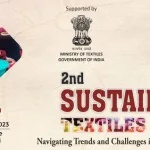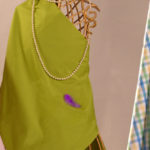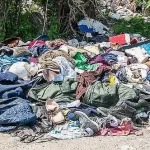Biofacture : Researchers Hope that – by 2050 – Textiles will be Made from Synthetic Biology
Discover how the latest textiles are dreamt up and can be made, bringing the worlds of art, design and science ever closer.
Carole Collet, Reader in Textile Futures, Deputy Director TFRC Research Centre, Central Saint Martins College of Art and Design, University of the Arts London, has been very active in conducting research into plant architecture, biological morphogenesis and synthetic biology. Carol’s research offers a truly profound perspective into how we might program plant cells to grow into ready-to-pick luxury textile products in the future. Should plants be genetically controlled to perform specific functions for us, there lies an opportunity to re-consider and re-evaluate our current design tools and methods.

Left : Gold Nano Spinach (Spinacia Aurea Electrica) Produces bio nano transistors for the electronic sector, and multi-mineral food supplements, a 2050 design scenario. Right : Factor 60 Tomato (Solanum Lycopene Fabricae) : Produces high levels of Lycopene for UV skin protection Factor 60, and protein rich -bacon favoured edible tomato lace for haute cuisine.

Left : Strawberry Noir (Fragaria Fusca Tenebris) Produces black strawberries with high levels of anthocyanin and Vitamin C, and black lace doilies for the fashion market. Right : Basil n° 5 (Ocimum Basilicum Rosa) Produces perfumed lace for luxury fashion trimmings, culinary herb and anti-viral medicinal fibre fabrics for the fashion market.
2050 :
Hydroponic greenhouse to grow engineered plants that produce high performance fruits and vegetables as well as textiles and semi electronic components from their genetically programmed roots.

Strawberry Noir
(Fragaria Fusca Tenebris)
Produces black strawberries with high levels of anthocyanin and Vitamin C, and black
lace doilies for the fashion market.
This post 2050 design scenario presents a radical means to combine food and textile production. If plants could be designed to replace textile machinery whilst also providing food, we are presented with an opportunity to address a looming ecological crisis caused by resource shortages and overpopulation.
Biolace presents a series of design probes that illustrate the potential of synthetic biology for the future manufacturing of textiles – what Collet calls biofacture.
BioLace :

Carole Collet (Reader & Dy Director, Textile Futures Research Centre, Central Saint Martins College, London)
Textiles of Future will have immense new possibilities and opportunities presented by these attractive materials in many fields. Such as sport (Sportex) and transport (Mobiltex): thermal isolation, composite material… ; health (Medtex): smart textiles, Health-giving fabrics, microencapsulation…; fashion (Clothtex), the most familiar sector to the public: current trends in prêt-à-porter and haute couture with Jean Charles De Castelbajac, Elisa Strozyk’s wooden textiles and Jum Nakao’s Lacy paper…; design and architecture (Buildtex): textile Reinforcement, lighter and stronger textiles with sophisticated materials, eco-friendly, air-supported structures… contemporary art is also making full use of those technical developments.
Carol Collet may be contacted at : [email protected]




